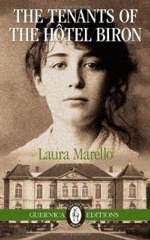

Guernica Editions (CAN), paperback, 978550713596
THE TENANTS OF THE HÔTEL BIRON
Reviewed by Kathleen Ambrogi
Laura Marello's creative exploration of the Hôtel Biron in Paris between 1908 and 1912 is an historical novel, an art history, a collection of essays and an epistolary novel. She takes as her starting point the fact that during these years an extraordinary collection of artists resided in apartments above sculptor Auguste Rodin's studio, in what is today the Rodin Museum (Musée Rodin) in Paris. Among them were painter Henri Matisse, poets Rainer Maria Rilke and Jean Cocteau, and the American photographer Eduard (Edward) Steichen. Other important artists appear in this heady bohemian circle, but at the center of this exploration is Camille Claudel, Rodin's sometime student, muse and lover, whose sculptural works share space with his in the Rodin Museum today.
Part of what puzzles the reader will be familiar from other historical novels. In this fictional retelling of actual history, how many of the facts are true? How closely do these voices match their owners' actual words and attitudes? It is entirely true that Eduard Steichen, a young painter and budding photographer, worked with Alfred Stieglitz on his early and influential magazine, Camera Work. However, did he also ask his fellow tenants at the Hôtel Biron to submit articles for publication in it? According to this novel, he did, and so we have their words—or at least their words as Marello imagines them—to tell us the stories of their lives, their art and their views of each others' lives and work. Included are:
• Henri Rousseau's fictional account of Rodin's apprenticeship
• Pablo Picasso's description of popular "isms" in art
• Composer Erik Satie's general tips on life, health, interior decorating and family
finance
• Henri Matisse's descriptions of the personalities of most of the others mentioned here
• Nijinsky's Spiritual Exercises
To bind all these bits and pieces together, two voices appear throughout. First is Steichen's, both his journal and his introductions to each of the others' writings (supposedly collected by him over the course of decades). Second—and to my mind more compelling—are the six sections entitled "Letters Never Sent: The Letters of Camille Claudel." Here, Claudel writes to Rodin about their work, his betrayal, her pain and bitterness. The letters date from 1881, when she was only 17 and already falling in love with her much-older teacher, and they end in 1943, shortly before her death, long after Rodin himself had passed away. Although it is not clear how much of this material is conjecture, Claudel's real life story is indeed a sad one, a 19th and 20th century cautionary tale about women who reach too high, women who forget their place and dare to be artists. It is both inspiring and frightening.
Marello certainly knows her subject, and she's distilled her knowledge into personae who reveal
themselves, their art and their world as they might have in their own day. Rodin himself never
speaks directly, even though he is at the center of the Hôtel that became the repository
of his life's work. But he need not speak; we see him through the eyes and ears of others,
most especially Camille Claudel and her alter ego, Laura Marello. This brief foray will
send you scurrying to Wikipedia, histories and biographies for more about these fascinating people.
Marello entertains and enlightens, but also whets the appetite for more.
